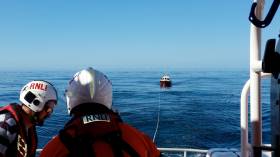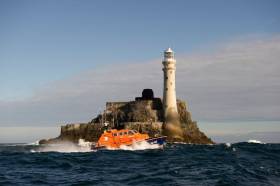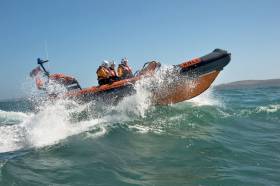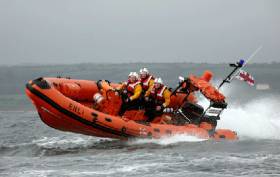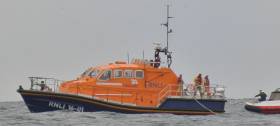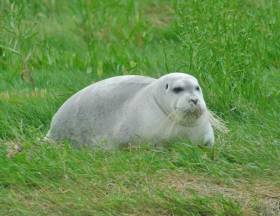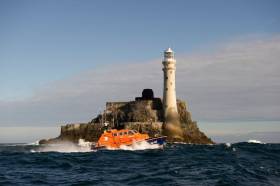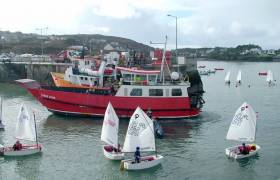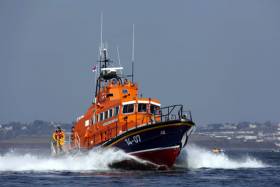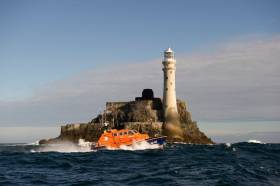Displaying items by tag: west cork
West Cork Lifeboats Launch To Stranded Tug & Angling Boat
#RNLI - Lifeboats from Baltimore and Castletownbere launched two separate callouts off West Cork since Friday (1 September).
Baltimore RNLI was called out yesterday morning (Saturday 2 September) to a tug with three people on board, which had broken down north of Drowlaun Point off Sherkin Island.
The volunteer crew launched their all-weather lifeboat at 9.45am after they were alerted by the skipper of the 12.5m tug. They arrived on scene seven minutes later and quickly established a tow to Baltimore Harbour within an hour.
Conditions at the time were good, with a southerly Force 4-5 wind and a calm sea ahead of the much poorer weather forecast for later in the day.
Elsewhere, Castletownbere RNLI lifeboat was launched on Friday morning to a 30ft angling boat with mechanical failure three miles south-east of Crow Head on the Beara Peninsula.
The lifeboat, under the command of Coxswain Brian O’Driscoll, was launched on service within minutes and proceeded to the casualty some nine miles southwest of Castletownbere Harbour.
The casualty was located in fine weather conditions at 11.07am. RNLI volunteers passed a towrope to the anglers’ onboard and the lifeboat took the vessel under tow to Castletownbere, where it was berthed alongside the pier 90 minutes later.
Baltimore Lifeboat Launches To Boat Aground In Heavy Fog
#RNLI - Baltimore RNLI launched in the early hours of yesterday morning (Thursday 17 August) after a boat ran aground in heavy fog near the West Cork village.
The volunteer lifeboat crew were paged at 00.39am to assist the 50ft vessel with three people on board. Sea conditions in the area were calm, but visibility was poor due to fog.
Under the command of coxswain Kieran Cotter and with mechanic Cathal Cottrell and crew members Pat Collins, Kieran Collins, Don O’Donovan, Jerry Smith and Micheal Cottrell, the lifeboat reached the vessel within 15 minutes.
After assessing the grounded boat’s situation and checking the surrounding area for any navigational hazards, a tow was established and the vessel was pulled clear.
There was no apparent damage to the vessel and no injuries to anyone on board, so it was allowed to move under its own power Baltimore Harbour, where it arrived escorted by the lifeboat at 1.20am.
Speaking following the callout, Baltimore RNLI volunteer lifeboat press officer Kate Callanan said: “With bad weather forecast for the next few days we would remind everyone taking to the sea to respect the water.”
Earlier in the week, Baltimore RNLI launched on Tuesday night (15 August) after reports of a flare sighted at Gokane Point, near Toe Head.
However, the lifeboat was stood down en route when the Irish Coast Guard learned that the flare was actually a firework set off from land and not a boat in distress.
Elsewhere, Arklow RNLI’s volunteers launched yesterday afternoon following a pager alert to a call for help from a sailing vessel with engine trouble.
In moderate seas, the lifeboat Ger Tigchlearr proceeded to the reported position of the casualty vessel, some four miles north east of Arklow Harbour and with two people on board.
Once on scene, the vessel and crew of the casualty vessel were found be in good order, and a towline was established it bring the boat back to Arklow.
John Tyrrell, Arklow RNLI’s lifeboat operations manager, commented: “Our crew were able to get the casualty vessel in a timely fashion. We would like to commend the skipper of the boat for calling for help at an early stage.”
#RNLI - Baltimore RNLI assisted two sailors yesterday evening (Monday 14 August) after their yacht lost power off Mizen Head in West Cork.
The alarm was raised earlier in the afternoon following a report from the crew of a 26ft yacht that they had lost all battery power.
At the time, the occupants were comfortable sailing the yacht towards Baltimore, so the lifeboat was put on standby until they were closer.
However, due to a confused sea in a strong tideway, the yacht was making very little progress towards land and required assistance to get to port.
The inshore lifeboat, helmed by Micheal Cottrell and with crew members Ryan O’Mahony and Colin Rochford on board, left station at 7.20pm and met the yacht three miles west of Cape Clear Island just before 8pm.
Weather conditions at the time were relatively good, with a Force 3 south-westerly wind and a one-metre sea swell.
One of the lifeboat crew went aboard the yacht to assist with rigging a tow and, once that was established at 8.05pm, a course was set for North Harbour in Cape Clear where the vessel was moored safely at 8.55pm.
Speaking following the callout, Cottrell said: “The sailors did the right thing in initially alerting people ashore to their predicament and then seeking the assistance of the lifeboat before darkness when their situation wasn’t improving.”
Teen Anglers Rescued In Glandore Harbour By Union Hall Lifeboat
#RNLI - Union Hall RNLI were tasked yesterday evening (Friday 11 August) by Valentia Coast Guard to a 16ft pleasure craft with five teenagers aboard that suffered engine failure in West Cork’s Glandore Harbour.
The lifeboat was launched and underway at 6.05pm to go to the aid of the casualty vessel, whose passengers had been angling at the eastern entrance of the harbour.
In favourable weather conditions, the Union Hall lifeboat was on scene within a few minutes to assist the pleasure craft as its position was a mere 15 feet away from rocks.
Following the incident, the five teenagers and their parents called to the lifeboat station to thank the volunteer crew for coming to their aid.
Martin Limrick, Union Hall RNLI volunteer lifeboat crew member, said: “The teenagers did everything right. They rang for help, deployed their anchor and were all wearing lifejackets.
“We would urge people when heading out on the water to have a means of communication, always wear a lifejacket and to respect the water.”
Fastnet Callout Sees Baltimore Lifeboat Bring Two To Safety
#RNLI - Two people watching the Fastnet Race fleet round the famous rock from a RIB yesterday (Tuesday 8 August) were rescued by Baltimore RNLI when their boat lost power.
The volunteer lifeboat crew, who were already on exercise in the area of Fastnet Rock, were alerted by a call from a nearby vessel at 3.15pm that another boat with two people onboard had lost the use of their engine.
The all-lifeboat was only two miles from the casualty vessel, a 7.5m RIB. Conditions at the time were good with a north-westerly Force 2-3 wind and a one-metre sea swell.
Once on scene, the lifeboat crew established a tow and brought the vessel back to Baltimore Harbour in West Cork, securing her to the pontoon before returning to the lifeboat station at 4.20pm.
Kate Callanan, Baltimore RNLI volunteer lifeboat press officer, commented: “Thankfully the lifeboat crew were on scene very quickly after the call was raised.
“Baltimore RNLI has a strong connection to the Fastnet Race having been involved in a number of dramatic rescues over the years. The lifeboat crew regularly exercise during the famous race to be nearby in case they receive a call for help.”
Elsewhere, Wicklow’s all-weather lifeboat launched at on Monday night (7 August) to assist two sailors on a yacht in difficulties about two miles north-east of Wicklow Harbour.
The eight-metre yacht was on passage south when it developed engine problems. The skipper contacted the Irish Coast Guard for assistance as they were unable to make any progress due to the lack of wind.
Under the command of second coxswain Ciaran Doyle, the lifeboat was alongside the casualty six minutes after launching. Conditions in the area had a calm sea state with light airs and good visibility.
A towline was quickly established and the yacht was brought back to Wicklow Harbour, where it was safely secured alongside the East Pier before midnight.
Arctic ‘Bearded’ Seal In West Cork Baffles Experts
#MarineWildlife - Wildlife watchers have been baffled by the sighting of an Arctic seal in West Cork, as the Irish Examiner reports.
Bearded seals, marked by their pale pelt and distinctive long whiskers, are usually found between the far north of Canada, Greenland and the Russian Arctic.
But as photographed in recent days by Shearwater Wildlife Tours, one appears to have taken up residence in the much milder climes of Timoleague, near Courtmacsherry in West Cork.
And it’s been suggested in comments that the heavyweight seal has been living in the area for at least the last two months.
It marks only the second recorded sighting of this marine mammal species in Ireland, the other being a female in distress who was nursed back to health in Galway in 2002, according to Shearwater’s Paul Connaughton, who is also chair of Birdwatch Ireland’s West Cork branch.
Others have been found in the Scotland’s Shetland and Orkney Islands, but fewer than 20 are on record.
Now experts are speculating as to whether melting sea ice in their Arctic home is prompting these seals to seek refuge further south.
The Irish Examiner has much more on the story HERE.
Baltimore Lifeboat Secures Vessels In Trouble At Crookhaven
#RNLI - In the first of two incidents yesterday morning (Thursday 3 August), Baltimore RNLI launched to reports of a vessel adrift in Crookhaven Harbour.
The vessel, a 4m Boston Whaler powerboat, had broken from its mooring in strong winds and was drifting outside the West Cork harbour.
There was no one on board the vessel, and weather conditions at the time were poor, with an easterly force 6-7 wind and 4-5m sea swell.
Baltimore's lifeboat arrived on scene at 8.38am, some 51 minutes after launch, and established a tow to bring the vessel back into the harbour, where it was secured to a mooring.
As the lifeboat was departing to return to station at 9.11am, the Irish Coast Guard contacted them to investigate another boat in trouble in the area.
The second vessel, a 20ft Merry Fisher pleasure boat with no people on board, had gone ashore on rocks in Crookhaven.
Due to the position of the vessel on the shoreline, coxswain Aidan Bushe decided to launch the Y-boat from the stern ramp of the lifeboat.
The Y-boat, with Kieran Collins and David Ryan on board, secured a tow and pulled the casualty vessel clear of the shoreline. The lifeboat then took up the tow and secured the vessel on a mooring.
Speaking following the callout, Baltimore RNLI volunteer lifeboat press officer Kate Callanan said: “It is advisable in such incidents, where boats get into trouble near the shoreline, to call the coastguard for assistance. This reduces the risk of people getting themselves into a dangerous situation.
“If you get into difficulty at sea, call 999 or 112 and ask for the coastguard.”
Bushe, Ryan and Collins were joined on yesterday’s callout by mechanic Sean McCarthy and crew members Jerry Smith and Don O’Donovan. Micheal Cottrell provided shore crew assistance at the lifeboat house.
Lost Boats Led To Forming Baltimore Sailing Club
Baltimore will become a centre for sailing over the next few weeks. This August weekend the annual sailing trek to the waters around Carbery’s Hundred Isles will get underway with the annual overnight race from Crosshaven to Schull. For the next few weeks the Cork sailing fraternity will be joined by boats from the East Coast, taking in events like Calves Week, Baltimore Regatta, racing around the Fastnet and the legendary Cape Clear Regatta.
The date when the club was founded varies, according to which account you take it from. A list of Commodores in the club starts in 1952 but a letter dated 3rd August 1976, written by Frank Murphy, who was the first Secretary of the club, stated that the club was founded in the summer of 1953. However, the Minutes of a Meeting held at Salters premises in Baltimore on Saturday 28th July 1956 state that "It was unanimously felt that a Sailing Club should be formed”
On my podcast this week I talk to a former Commodore of the Club, Gerald O’Flynn, who puts that date as the one when the club was formed.
Its story, set up originally as a Summer sailing club for Cork families with second homes in the fishing village, began when some of those seasonal residents lost boats in storms while they were kept at nearby Tragumna beach.
Gerald O’Flynn tells the story of boats built and bought for £75 each in ‘old’ money; about a ‘bastard-type’ of National 18, Enterprises and Fireball dinghies used by the club, the running of National Dinghy Week and the time when the club annoyed locals by covering grass areas on the pier with concrete. It’s a fascinating story about a club with a strong family emphasis which he told me in its modern premises which these days operates for a wider period than just Summer.
Listen to the PODCAST here:
• Tom MacSweeney presents THIS ISLAND NATION radio programme on local stations around Ireland.
Engine Failure On West Cork Fishing Trip Vessel Prompts Courtmacsherry Lifeboat Rescue
#RNLI - Courtmacsherry RNLI’s all-weather lifeboat was called out at 4.20pm yesterday afternoon (Tuesday 1 August) to go to the aid of a 40ft pleasure fishing boat with mechanical failure 15 miles off the Seven Heads in West Cork.
The Courtmacsherry Lifeboat, under coxswain Kevin Young and with a crew of six, launched in minutes and reached the stricken boat just after 5pm.
On scene near the Lusitania site, the lifeboat secured a tow line to the vessel and then proceeded to tow it back to the safe haven of Courtmacsherry’s inner harbour.
All six on the pleasure boat were safely returned to Courtmacsherry Pontoon at 8pm.
Weather conditions on the callout reasonable, with winds in the area blowing Force 3-4.
The callout was the latest in what was a busy 48 hours for the voluntary crew of Courtmacsherry RNLI, with three callouts to boats in distress beginning on Sunday afternoon with the rescue of another pleasure fishing boat, as previously reported on Afloat.ie.
#RNLI - Baltimore RNLI launched this morning (Friday 28 July) to locate a vessel sending an alarm from their positioning beacon off the coast of West Cork.
The Irish Coast Guard requested the launch just before 10am after it had picked up an alarm from an EPIRB (electronic position indication radio beacon) on a yacht half a mile south west of Cape Clear Island.
Coastguard staff at Mizen Head had no success raising the occupants of the yacht on their VHF so the Baltimore all-weather lifeboat was launched to investigate at the last known co-ordinates of the vessel.
Meanwhile, 10.30am the coastguard finally made contact with the yacht’s two occupants on their VHF and established that the EPIRB had been activated by accident.
Speaking after the callout, Baltimore RNLI volunteer lifeboat navigator Micheal Cottrell said: “It is important to ensure the secure fastening of an EPIRB on board a vessel and to regularly check that it is in good working order. Also, whilst out at sea it is important to keep radio watch on Channel 16.
“If you get into difficulty at sea, call 999 or 112 and ask for the coastguard.”


























